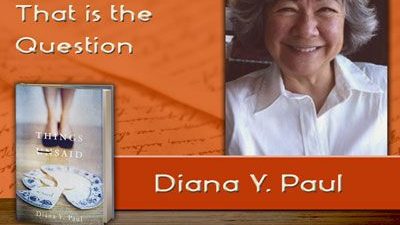Bio
Diana was born in Akron, Ohio and is a graduate of Northwestern University with a degree in both psychology and philosophy. And, of the University of Wisconsin–Madison, with a PhD in Buddhist studies. She is the author of three books on Buddhism, one of which has been translated into Japanese and German (Women in Buddhism, University of California Press). Her short stories have appeared in a number of literary journals and she is currently working on a second novel, A Perfect Match. To learn more about her and her work, visit her other website at www.unhealedwound.com. She lives in Carmel, CA with her husband, Doug, and two cats, Neko and Mao. Diana and Doug enjoy visiting their two adult children: Maya Miller ( San Francisco) and Keith Paul (Los Angeles) as often as they can.
Things Unsaid is her debut novel published with She Writes Press available on Amazon and your favorite indie bookstore.
Connect with Diana Y. Paul
Awesome Blog Title
A good story is all about character. And plot is also character. Even action-thrillers are driven by a hero or heroine. As a novelist, I always aim for intriguing characters who stand out from the page, fully formed, coming so alive the reader understands them, may love them, sometimes hate them, or sometimes both. The more complex the motivation, the more freedom I have to reveal each character had something that could have been appealing, could have made them a better person, given the right circumstances. I have a deep affection for flawed characters. That does not mean I want to be their friend.
The most daunting feat for me, in writing a novel, is the psychology of the characters, to make them understandable so that the reader can connect with each of them. Begin with a stereotype and you have nothing– a cartoon. Begin with a richly-drawn, three-dimensional character and you will reveal someone universal. Characters must be authentic. Real. And that means imperfect.
Character flaws, –blind spots—can explain the changes that take place later on as the plot unfolds. The double-bind dilemma: when the flaws become a catalyst for survival and change, when the main character must face her demons. Characters who don’t keep promises or who are self-absorbed and vain,– “I told you so” friends,– here’s where the novelist’s double vision comes in. I can write from within the character’s viewpoint, sympathizing with (or at least understanding) her, while at the same time being perfectly aware of what outside readers think of her. I get to see both points of view: the character’s and the reader’s!
Conflicts arise. There’s free will to make positive –or negative– choices. Stuff happens. For a reason. We want a protagonist who takes charge of his or her life, and ends the story in a better place. The flawed character can be unappealing, but in the hero, those flaws can become strengths. However, these types of protagonists—anti-heroes– require caution. A good example of a cautionary tale is Walter White, the anti-hero in the television series “Breaking Bad”, who teeters at the edge of revulsion from the viewer. Despising his ruthless behavior, the viewer should still be able to understand the intentions he had, even though misdirected. Life teaches lessons. Conflicts can be resolved.
“I want to give the reader a glimpse into all the characters’ souls…”
In Things Unsaid, my clueless main character, Jules Foster, has to have more beneath the surface than what we first see. A brief scene can reveal her in a positive light, and this is essential to understanding her view of her family. As an author, I want to give the reader a glimpse into all the characters’ souls so the reader begins to understand their poor decisions, hostile behavior, sour relationships. The “why” of who they are. Without the WHY, a reader is unable to connect, on a deeper level, with either the protagonist or those opposing her. In analyzing flawed characters, I hope the reader asks: “What blindsides me?”
Contrasts between positive and negative traits work best when they’re not absolutes, but fluid and impermanent. Once I conceptualize the flaw, I think of each character’s compensating positive traits. The weaknesses I find most fun to discover and write about are character traits that are not inherently negative. And, if all else fails, I can always resort to a love of animals. But, I never had to use that one in Things Unsaid!
So, for Aida, the main antagonist in the narrative, she became narcissistic because of broken dreams. The reader hopefully sees at least a glimmer of the person she could have been. The past is not an excuse for her behavior, but it is a window to understanding why she is the person she has become.
We all make mistakes. Surely everyone can name at least one thing in their lives they regret bitterly and wish had never happened, and which was their fault, as opposed to someone else’s. I want to write in such a way that all the characters are revealed in an entirely new light at some point in their lives, surprising the reader who expected a different turn of events.





